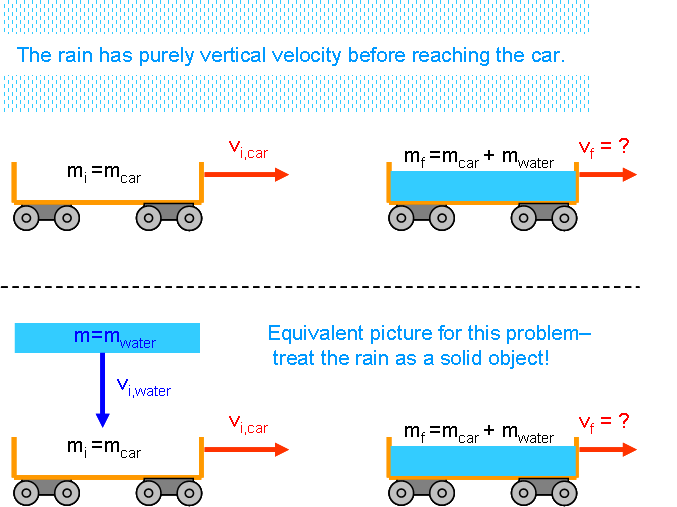A railroad car that is open on the top is rolling freely (without friction) along a straight, level section of track when it begins to rain heavily at a steady rate. The rain collects in the car at a rate of 1.0 cm per minute. The dimensions of the car are 10.0 m long by 3.0 m wide and the mass of the (empty) car is 1200 kg.
Part A
If the car was initially moving at a rate of 2.5 m/s and the rain is falling straight down, what is the speed of the car 2.0 minutes after the rain has begun?
Solution
System:
Interactions:
We will ignore the vertical direction, so there are no relevant external forces (gravity and the normal force each provide no x-component).
The y direction can be neglected here because the normal force of the ground guarantees that the train car will not accelerate in the y direction. One advantage of the vector nature of momentum is that even though the y-momentum of our system is clearly not conserved, the x-momentum is conserved.
Model:
Approach:
Diagrammatic Representation
As remarked above, because the rain has only a y-velocity initially, we can treat the process of collecting the rain as a typical collision in the x-direction, with momentum conserved. Thus, we can effectively diagram the situation as shown below.

Mathematical Representation
Since there is no friction and the track is level, any change in the speed of the car must be due to the rain. By including the rain in our system, we have ensured that all x-forces are internal. Thus, the x-momentum must be a constant. We can therefore write:
\begin
[ p^
_
= p^
_
+ p^
_
= p^
_
= p^
_
+ p^
_
] \end
We define the initial time to be the instant before it begins to rain, because we have information about the car's velocity at that point. The final time is taken to be 2.0 seconds after the rain begins. Before the rain has accumulated in the car, it has zero x-velocity and hence zero x-momentum. After it has accumulated in the car, it is moving with the same speed as the train car. Thus, we can write:
\begin
[ m^
_
= \left(m^
+ m^
\right)v_
] \end
It might be confusing that we can treat the rain, which falls individually as drops, as if it were one solid object. The reason we can get away with this is the assumption that all the rain drops fall with exactly the same x-momentum, and that they end up at rest with respect to the car. Because all the drops experience the same momentum change we can simply group them together and consider the momentum of the "rain block".
All that remains is to determine the mass of the rain. We can do this by noting that the density of water is 1000 kg/m3 and that the water has filled the car to 2.0 cm deep, indicating a collected mass of:
\begin
[ m^
= \rho^
V^
= (\mbox
^
)(\mbox
\times\mbox
\times\mbox
) = \mbox
]\end
where ρwater is the density of water and Vrain is the volume of the accumulated rain.
We can now solve to find:
\begin
[ v_
= \frac{m^
_{x,i}}{m^
+ m^{\rm rain}} = \mbox
]\end
Part B
Consider again the situation of Part A. Suppose that the rain is falling with a speed of 10.0 m/s, and that it comes to rest with respect to the train car immediately upon impact. At the instant the rain begins to hit the car, what is the force exerted on the train car by the rain?
Solution
System:
Interactions:
Model:
Approach: